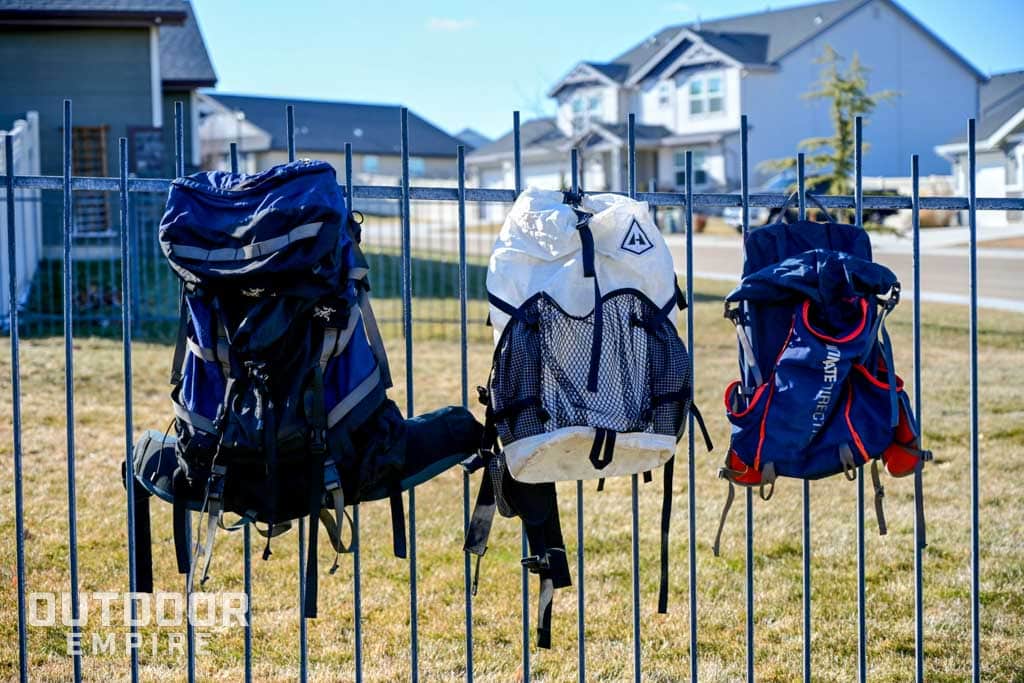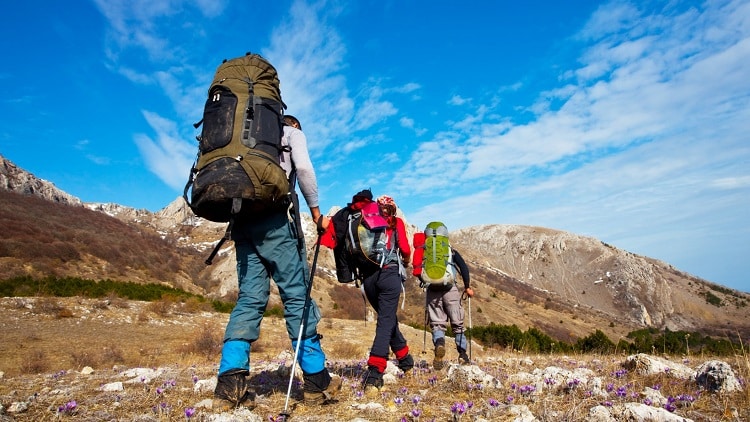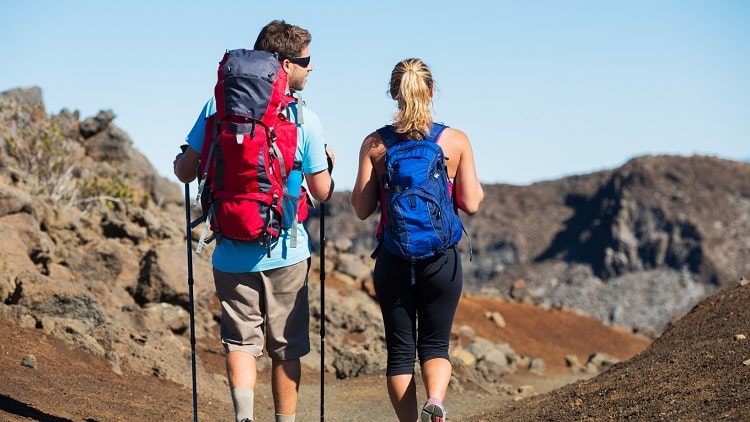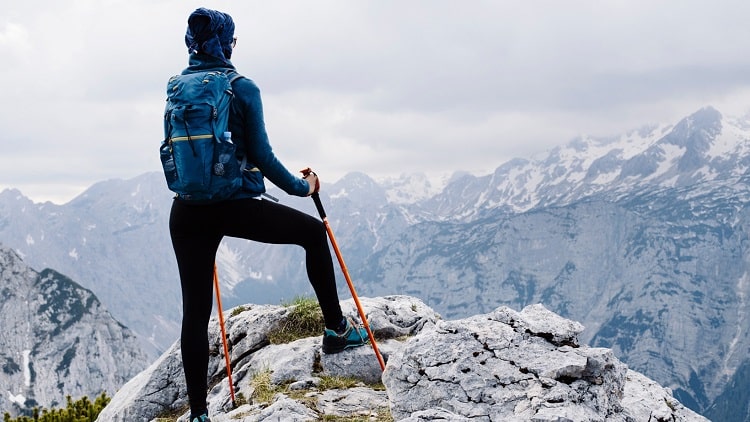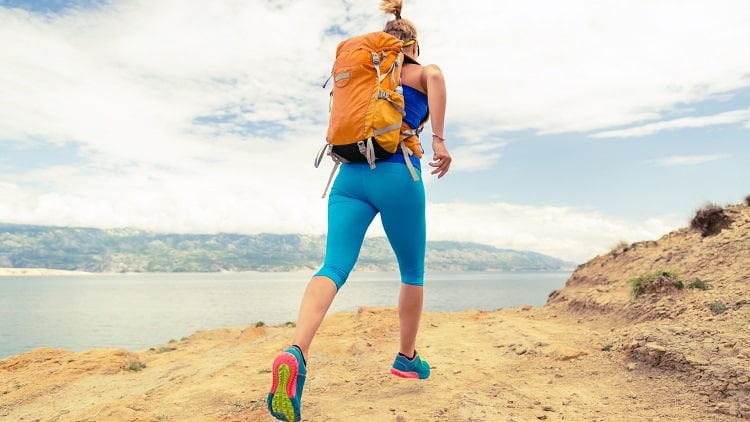Ultralight backpacking is nothing new. In fact, Emma Gatewood, AKA Grandma Gatewood, first thru-hiked the 2,168-mile Appalachian Trail in 1955 at the age of 67 while carrying her ultralight kit in a gunny sack draped over her shoulder.
Do you know the first thing other hikers probably asked her on the trail?
“What’s your base weight?“
Several things have changed in the past 70 or so years, including gear, materials, and styles. But the one thing that has not changed is a backpacker’s obsession with the amount of weight that is carried on their back.
What Base Weight Means in Backpacking
In the modern era, when we talk about pack weight, it is divided into two categories. Base weight and overall weight. Both are important, but base weight is what we will discuss in this article.
Base weight is the total weight of your pack, as you will carry it, minus any consumable items you use along the way like food, water, and fuel. Primary items like a sleeping system, tent, and backpack are included in your base weight. Clothing is generally not included.
You can choose if you want to include your toilet paper or not.
How to Measure Base Weight
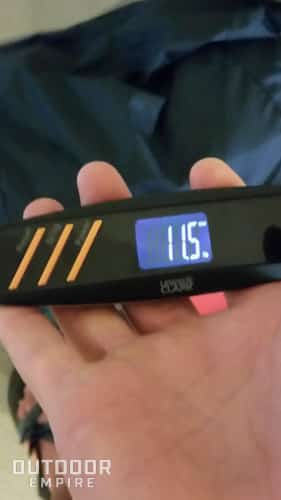
Measuring base weight is a straightforward process. Pack your backpack with everything that you are going to carry in it, minus clothing, food, water, fuel, and maybe toilet paper, then weigh the pack.
Your base weight does not include the clothes you will wear while hiking or anything in your pockets. You can stuff your pants pockets with items that should be in your pack just so you can claim a lower base weight, but you are only fooling yourself.
The key here is to have a system and do it the same way each time.
What’s a Good Base Weight for Backpacking?
In general, there are three different categories of backpacking, each of which is associated with varying base weights. They are standard or traditional backpacking, lightweight backpacking, and ultralight backpacking. In the last several years, a fourth category has also emerged, called fastpacking.
In this section, we will discuss each of these categories and discuss acceptable base weights, pros and cons, and average daily mileage. We will also talk about the best places to find equipment.
Backpacking Base Weight Chart
| Type of
Backpacking |
Base weight | Miles per Day | Pros | Cons |
| Traditional | 15 to 20 lbs | Under 10 | Comfortable while in Camp | Uncomfortably heavy while hiking |
| Lightweight | 10 to 20 lbs | 10 to 20 | Best of both worlds | Very Few |
| Ultralight | Under 20 lbs | Over 20 | Makes your backpack feel like a day pack | Gear is less comfortable at camp |
Traditional Backpacking Base Weight
Traditional backpacking is what comes to mind when most people think about backpacking. This includes big robust packs, comfy sleeping pads, and large heavy tents. Imagine a Boy Scout troop doing a weeklong 50-mile trip with large overstuffed packs.
Base Weight
The base weight of traditional backpacking is generally 15 to 20 pounds.
Pros
- Most of the stuff in this category is very comfortable
- There are generally cheap options
- The equipment is more durable
- You can eat like a king
Cons
- You have to carry all that comfort on your back
- Heavy
- The weight limits the distance you can travel in a day
- The weight makes the hiking portion of the day uncomfortable
- Off-trail travel becomes more difficult
Trade-Offs
With a traditional set up you are choosing comfort and durability over weight. This means you will be more comfortable in camp but more miserable while hiking. Traditional backpacking also requires less skill than ultralight backpacking.
Miles Per Day Recommendation and Types of Trips
Traditional gear is best used when hiking less than 10 miles per day. I use a more conventional setup when I plan on walking into an area, then setting up a base camp and exploring the area on day hikes from there. I also tend to carry a traditional setup when camping with my kids, as they can be hard on the less durable ultralight gear.
Best Place to Buy Traditional Backpacking Gear
If you want a traditional backpacking setup, then just go to REI or a similar store, and ask the sales associate to deck you out for a weeklong backpacking trip, and you will be set.
Lightweight Backpacking Base Weight
Lightweight backpacking has really come into its own over the last 20 years. With improvements in material and manufacturing techniques, it is possible to have all the comforts of a traditional setup with less weight. Plus, you don’t have to sacrifice durability like you once did.
With this new lighter gear, lightweight backpacking has become accessible for more people. It also does not require the same level of skill or neuroticism as ultralight backpacking.
To be honest, this is the category that I find myself in for 90% of my trips. It is the “one size fits most” category and where I push most beginner and intermediate backpackers especially if they are not interested in really long mile days.
Base Weight
10 to 15 pounds is an acceptable base weight for this category.
Pros
- Light enough for most trips
- Not as expensive as ultralight-weight backpacking gear
- You don’t have to lose sleep over whether you overpacked by 3 ounces
- The gear is easy to get
Cons
- To be honest, I am having a hard time coming up with any cons
- Ok, maybe it is a little heavy if your objective is to hike 20 or more miles per day
Trade-Offs
While lightweight backpacking is most often the best of both worlds, it can sometimes be the worst—kind of the opposite of the Goldilocks setup. If you don’t balance weight and comfort appropriately, it can end up being too heavy while hiking and not as comfortable as it should be in camp.
Miles Per Day Recommendation and Types of Trips
Lightweight setups are designed for trips between 10 and 20 miles per day. This is also a good weight for shorter off-trail outings.
Best Places to Buy Lightweight Backpacking Gear
More and more places are offering lightweight setups. REI has come out with a great setup in this range. But when you walk in the door, you must be specific about what you are looking for.
Local outfitters are also a great resource but once again, you have to be specific and come prepared with the research already done. The biggest advantage to brick-and-mortar stores is that you can try out the gear before you buy it.
The internet is also a great place to look for lightweight gear. There is a multitude of cottage industries and direct-to-consumer companies that cater to the lightweight crowd. The hard part is that you can’t try before you buy.
It is best to do your homework and read reviews from a trusted source before buying online. I also try to find companies with liberal return policies.
Ultralight Backpacking Base Weight
Imagine a person deep in the backcountry with what looks like a day pack striding confidently along the trail. There is no way a full overnight kit fits in a small pack, right?
Also, it is best not to get too close to an ultralight backpacker. Because a toothbrush weighs too much and there is no use bringing extra clothes when you can just keep wearing the ones you used yesterday.
To tell you the truth, one of the best parts of ultralight backpacking is the look on people’s faces as you blow past them on the trail, out in the middle of nowhere, with a pack half the size of what they are carrying.
Total Base Weight
Anything under 10 pounds is considered ultralight.
Pros
- The lack of weight makes covering long miles easier
- Feeling smug about your base weight compared to those around you
- Ultralight-weight materials have come a long way in the last ten years
- Allows you to explore areas that you otherwise couldn’t access
- Great for the time-crunched backpacker
- Great for backpackers with knee or ankle issues
Cons
- You give up a certain amount of comfort and accessories while in camp
- Ultralight gear is not as durable and needs to be treated with more care
- Requires skills that are not necessary with standard backpacking
Trade-Offs
As I mentioned above, ultralight backpacking is a tradeoff between comfort while hiking versus comfort while in camp. While those two sides have come a lot closer recently, there is still a need to decide what is more important to you.
The other thing you are trading here is experience and skills for weight. As you learn to pick a better spot to pitch your tent, you can start to carry a lighter shelter. With every new skill you acquire, there is a lighter piece of gear that becomes available, or better yet, you can just leave it at home altogether.
Miles Per Day Recommendation and Types of Trips
Any time my trips exceed 20 miles per day my base weight tends to dip closer to the ultralight spectrum. Also, if there will be a significant amount of off-trail hiking or large amounts of vertical gain, then I want an ultralight pack.
The other group of people that tend to fall in this category are long-distance backpackers and through-hikers.
Best Places to Buy Ultralight Backpacking Gear
The best place to buy ultralight backpacking gear is online. There are companies that cater to the ultralight crowd. Only make your purchases after doing a significant amount of research and reading reviews. Some specialty shops are also starting to carry ultralight gear but you have to go prepared with your research or find a sales associate that really understands what you want.
Fastpacking
In recent years there has been a new category that has been created called fastpacking, and it is a subset of ultralight backpacking. While ultralight backpacking came from traditional backpackers who have whittled their gear down to the bare minimum, fastpacking came from trail runners who wanted to take their runs overnight.
Simply put, fastpacking is ultralight backpacking, but with some running thrown in for fun.
The Best Base Weight Is a Matter of Perspective
Several years ago, a friend and I decided to backpack into a remote lake in the Sawtooth Mountains of Central Idaho. We knew that there were no trails to the lake and that the access would be difficult, steep, and rocky. We decided to pack as light as possible and ended up at around 20 pounds of total weight for the three-day trip.
After enjoying the solitude of the remote lake, we hiked out and spent the last night at a popular, easy-to-reach lake. In the morning, we each ate the last of our dismal oatmeal packets and started toward our ride home.
On the other side of the lake, we encountered a friend finishing up a breakfast of fried potatoes who offered us generous portions of his leftovers.
As we wolfed them down, we discovered he was heading into the same remote lake we had just left, but his pack weighed an incredible 80 pounds. He had different objectives from us and, being a former Army Ranger, a much higher tolerance for suffering.
The moral of the story is that the ideal base weight is personal and different for everybody. Plus, the perfect base weight might differ for each trip. My base weight varies considerably depending on how far I plan to hike in a day, the time of year that I am going, who is going with me, and the trip’s main objectives.
If my goal is to hike all day and cover as many miles as possible, I strive for the lowest base weight that is possible and safe. However, if I am hiking a couple of miles to camp out overnight with my kids, I will pack more and be more worried about camp comfort than pack weight.
Also, if I am going to backpack during the shoulder season or winter, my base weight will be more so that I can add to my margin of safety.
How Much Base Weight is too Much?

Except for specific circumstances, anything over 20 to 25 pounds is too much base weight. We live in a time with amazing lightweight gear. Even if you are on a budget, finding comfortable and safe equipment that will keep your base weight under 20 to 25 pounds should be easy.
Here are some reasons you might find your base weight creeping up over that mark and it’s ok.
- You are taking your significant other on their first backpacking trip, and you want it to go great so you carry some of their gear.
- You are taking your kids backpacking and need to carry some of their gear.
- You are backpacking in extreme conditions and need to be extra prepared.
- You have a specific objective in mind that requires more and heavier gear, like climbing or photography.
How to Lower Your Backpacking Base Weight

Here is a quick guide on how to lower your base weight. Remember that this section could be a whole article itself, so these are just the high points. The initial investment can be spendy, but keep in mind that you don’t have to do it all at once. It can be dangerous to do it like that.
Take your time, and as you get more skilled and comfortable in the backcountry, you can take off more weight. In reality, this is a lifelong process of tweaking your setup until you get it just right. Actually, there is no such thing as “just right,” so you can research and buy gear your whole life. Enjoy that process.
1. Put Your “Big Three” on a Diet
The fastest way to lose weight off your back is to reduce the weight of your tent, sleep set up, and pack. Why these three, you ask? Because this is where you can stand to lose the most weight.
By cutting the end off your toothbrush, you lose an ounce or two, but if you can reduce the weight of your actual backpack from 6 pounds down to 2 pounds, you have instantly dropped 4 pounds! Similar drops can be made in your shelter and sleep system.
2. Optimize the Rest of your Kit and Reduce Redundancy
After the big three, you are not usually losing pounds but ounces, but those ounces add up. Take your time and think about each part of your kit. Do you really need a pot, a bowl, and a cup? Or can you just use your pot for everything?
Evaluate everything you put in your pack and decide if you really need it or if there is a lighter version of it after every trip. Reevaluate your kit and see what you used and what you didn’t.
We tend to pack our fears so as you become more skilled and comfortable, you will probably realize that you didn’t really need that ax after all.
3. Weigh Everything
This is where some people can go down a rabbit hole. There are people with spreadsheets of every piece of gear they own. I haven’t gone that far, but I suggest buying a high-quality scale so you can make informed decisions. I generally use the scale to help me decide between two options.
4. Avoid Last Minute Add-Ons
This is also not a good idea, just like throwing that last-minute Snickers bar and Mt Dew into your cart while you’re standing in the checkout line while your wife’s head is turned. Last-minute additions to your pack can add up.
Most last-minute items are thrown in on a whim without much thought, but a couple of ounces here and there can add up to pounds in a hurry.
5. Be OK With Being Uncomfortable
This is more an editorial than a tip. I think as a society, we have spent so much energy and money trying to be comfortable that we have forgotten that sometimes it’s ok not to be. In fact, all growth comes from discomfort.
I also believe that being miserable is something that we are taught. My kids were playing in the rain one time. They were wet and cold, but they did not realize they were miserable until I told them they were. Up until that point, they thought that they were having fun.
Sometimes ultralight backpacking is uncomfortable, but you know what? That’s ok.
6. Don’t be “Stupid Light”
There are two parts to this one. I know I just told you it is ok to be uncomfortable, but you must pack enough to be safe. Shaving weight off your pack can be addicting, but it can also be dangerous. Do your research, know the conditions, and pack accordingly.
The second part is don’t cut so much weight off a piece of gear that it becomes unusable. One time I cut the end off my spoon saving an ounce or so. I was so proud of myself and excited about how hardcore I was.
I spent the first several days of the trip so frustrated that I eventually put the spoon at the bottom of the pack and fashioned a new one out of wood. My new wooden spoon was functional but twice as heavy as the original would have been.
Concluding Thoughts
Figuring out the perfect base weight for you and the type of backpacking you want to do takes time and a lot of trial and error. Luckily that just means more backpacking, which is great.
My advice is don’t get too caught up in the numbers and have fun along the way. Also, don’t let your significant other see all of your {expensive} gear in one place at one time. That is very important.

